Sensing Performance and Mechanical Properties of Buckypaper Impregnated with Epoxy Resin
Abstract
:1. Introduction
2. Experimental
2.1. Preparation of Buckypaper
2.2. Buckypaper Impregnated with Epoxy
2.3. Characterization
3. Results and Discussions
3.1. Surface and Cross-Section Morphologies
3.2. Thermal Stability
3.3. Tensile Properties
3.4. Strain Sensing
3.5. Temperature Sensing
4. Conclusions
Author Contributions
Funding
Conflicts of Interest
References
- Iijima, S. Helical microtubules of graphitic carbon. Nature 1991, 354, 56–58. [Google Scholar] [CrossRef]
- Gojny, F.H.; Wichmann, M.H.G.; Kopke, U. Carbon nanotube-reinforced epoxy-composites: Enhanced stiffness and fracture toughness at low nanotube content. Compos. Sci. Technol. 2004, 64, 2363–2371. [Google Scholar] [CrossRef]
- Aloui, W.; Ltaief, A.; Bouazizi, A. Transparent and conductive multi walled carbon nanotubes flexible electrodes for optoelectronic applications. Superlattices Microstruct. 2013, 64, 581–589. [Google Scholar] [CrossRef]
- Tombler, T.W.; Zhou, X.C.; Alexseyev, L.; Kong, J.; Dai, H.; Liu, L. Reversible electromechanical characteristics of carbon nanotubes under local-probe manipulation. Nature 2000, 405, 769–772. [Google Scholar] [CrossRef]
- Hu, C.-F.; Su, W.-S.; Fang, W.-L. Development of patterned carbon nanotubes on a 3D polymer substrate for the flexible tactile sensor application. J. Micromech. Microeng. 2011, 21, 115012. [Google Scholar] [CrossRef]
- Lai, Y.-T.; Chen, Y.-M.; Yang, Y.-J. A novel CNT–PDMS-based tactile sensing array with resistivity retaining and recovering by using dielectrophoresis effect. J. Microelectromech. Syst. 2012, 21, 217–223. [Google Scholar] [CrossRef]
- Baughman, R.H. Carbon nanotube actuators. Science 1999, 284, 1340–1344. [Google Scholar] [CrossRef] [Green Version]
- Che, J.; Chen, P.; Chan-Park, M.B. High-strength carbon nanotube buckypaper composites as applied to free-standing electrodes for supercapacitors. J. Mater. Chem. A 2013, 1, 4057–4066. [Google Scholar] [CrossRef]
- Chen, Y.W.; Cheng, C.Y.; Miao, H.Y.; Zhang, M.; Liang, R.; Zhang, C. Application of response surface methodology in the optimization of laser treatment buckypaper lighting for field emission displays. Int. J. Adv. Manuf. Technol. 2013, 64, 515–536. [Google Scholar] [CrossRef]
- Liu, J.H.; Miao, H.Y.; Saravanan, L.; Wang, L.C.; Tsai, R.H. Fabrication of metal alloy deposited flexible MWCNT buckypaper for thermoelectric applications. J. Nanomater. 2013, 6, 635647. [Google Scholar] [CrossRef]
- Wang, X.; Lu, S.; Ma, K.; Xiong, X.; Zhang, H.; Xu, M. Tensile strain sensing of buckypaper and buckypaper composites. Mater. Des. 2015, 88, 414–419. [Google Scholar] [CrossRef]
- Lu, S.; Chen, D.; Wang, X.; Xiong, X.; Ma, K.; Zhang, L.; Meng, Q. Monitoring the manufacturing process of glass fiber reinforced composites with carbon nanotube buckypaper sensor. Polym. Test. 2016, 52, 79–84. [Google Scholar] [CrossRef]
- Wang, G.D.; Li, N.; Melly, S.K.; Peng, T.; Li, Y.C.; Zhao, Q.D.; Ji, S.D. Monitoring the drilling process of GFRP laminates with carbon nanotube buckypaper sensor. Compos. Struct. 2019, 208, 114–126. [Google Scholar] [CrossRef]
- Lu, S.; Chen, D.; Wang, X.; Xiong, X.; Ma, K.; Zhang, L.; Meng, Q. Monitoring the glass transition temperature of polymeric composites with carbon nanotube buckypaper sensor. Polym. Test. 2017, 57, 12–16. [Google Scholar] [CrossRef]
- Zangrossi, F.; Xu, F.; Warrior, N.; Karapappas, P.; Hou, X. Electro-thermal and mechanical performance of multi-wall carbon nanotubes buckypapers embedded in fibre reinforced polymer composites for ice protection applications. J. Compos. Mater. 2020, 54, 3457–3469. [Google Scholar] [CrossRef]
- Sharma, S.; Singh, B.P.; Chauhan, S.S.; Jyoti, J.; Arya, A.K.; Dhakate, S.R.; Kumar, V.; Yokozeki, T. Enhanced thermomechanical and electrical properties of multiwalled carbon nanotube paper reinforced epoxy laminar composites. Compos. Part A 2018, 104, 129–138. [Google Scholar] [CrossRef]
- Datta, S.; Neerukatti, R.K.; Chattopadhyay, A. Buckypaper embedded self-sensing composite for real-time fatigue damage diagnosis and prognosis. Carbon 2018, 139, 353–360. [Google Scholar] [CrossRef]
- Kumara, V.; Sharma, S.; Pathak, A.; Singh, B.P.; Dhakate, S.R.; Yokozeki, T.; Okada, T.; Ogasawara, T. Interleaved MWCNT buckypaper between CFRP laminates to improve through-thickness electrical conductivity and reducing lightning strike damage. Compos. Struct. 2019, 210, 581–589. [Google Scholar] [CrossRef]
- Ashrafi, B.; Guan, J.; Mirjalili, V.; Hubert, P.; Simard, B.; Johnston, A. Correlation between Young’s modulus and impregnation quality of epoxy-impregnated SWCNT buckypaper. Compos. Part A 2010, 41, 1184–1191. [Google Scholar] [CrossRef] [Green Version]
- Li, M.; Wang, Z.; Liu, Q.; Wang, S.; Gu, Y.; Li, Y.; Zhang, Z. Carbon Nanotube Film/Epoxy Composites With High Strength and Toughness. Polym. Compos. 2017, 38, 588–596. [Google Scholar] [CrossRef]
- Oliver, W.C.; Pharr, G.M. An improved technique for determining hardness and elastic modulus using load and displacement sensing indentation experiments. J. Mater. Res. 1992, 7, 1564–1583. [Google Scholar] [CrossRef]
- Zhang, Y.; Sheehan, C.J.; Zhai, J.; Zou, G.; Luo, H.; Xiong, J.; Zhu, Y.T.; Jia, Q.X. Polymer-Embedded Carbon Nanotube Ribbons for Stretchable Conductors. Adv. Mater. 2010, 22, 3027–3031. [Google Scholar] [CrossRef] [PubMed]
- Luo, S.; Liu, T. SWCNT/Graphite Nanoplatelet Hybrid Thin Films for Self- Temperature-Compensated, Highly Sensitive, and Extensible Piezoresistive Sensors. Adv. Mater. 2013, 25, 5650–5657. [Google Scholar] [CrossRef] [PubMed]
- Gong, S.; Wang, Y.; Xiao, Z.; Li, Z.; Wang, Z.X.; Lei, R.S.; Zhu, Z.H. Effect of temperature on the electrical property of epoxy composites with carbon nanotube. Compos. Sci. Technol. 2017, 149, 48–54. [Google Scholar] [CrossRef]
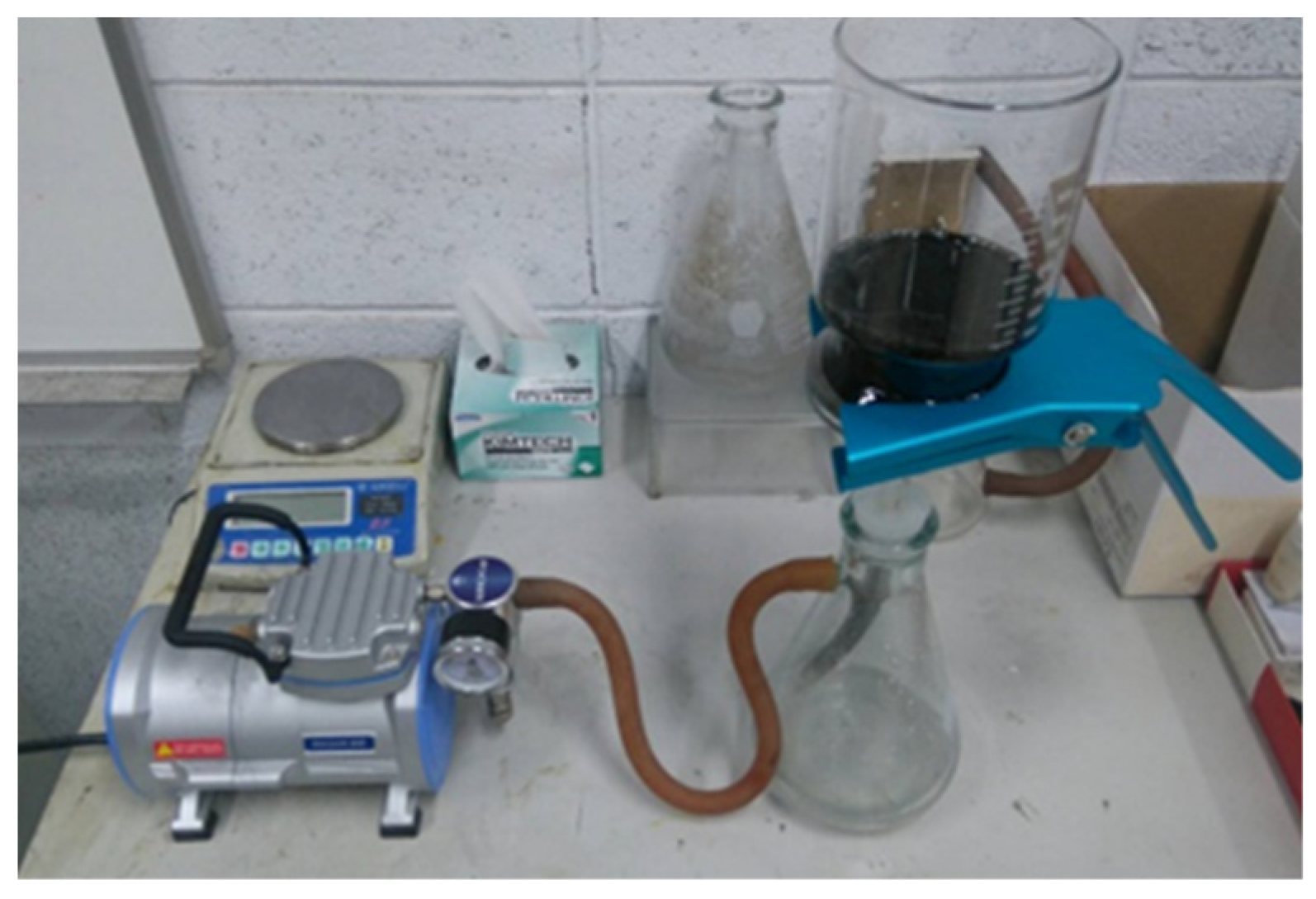
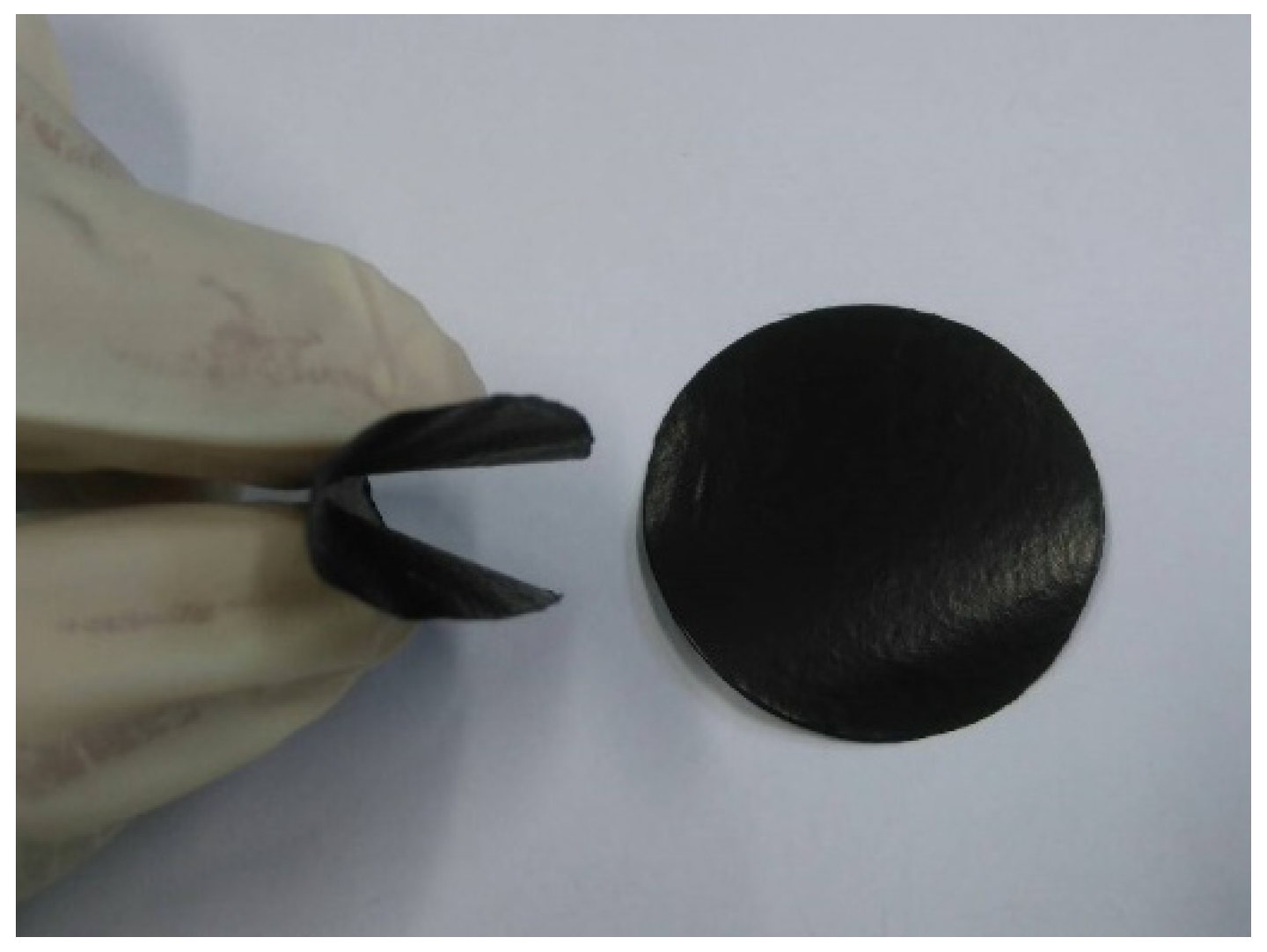
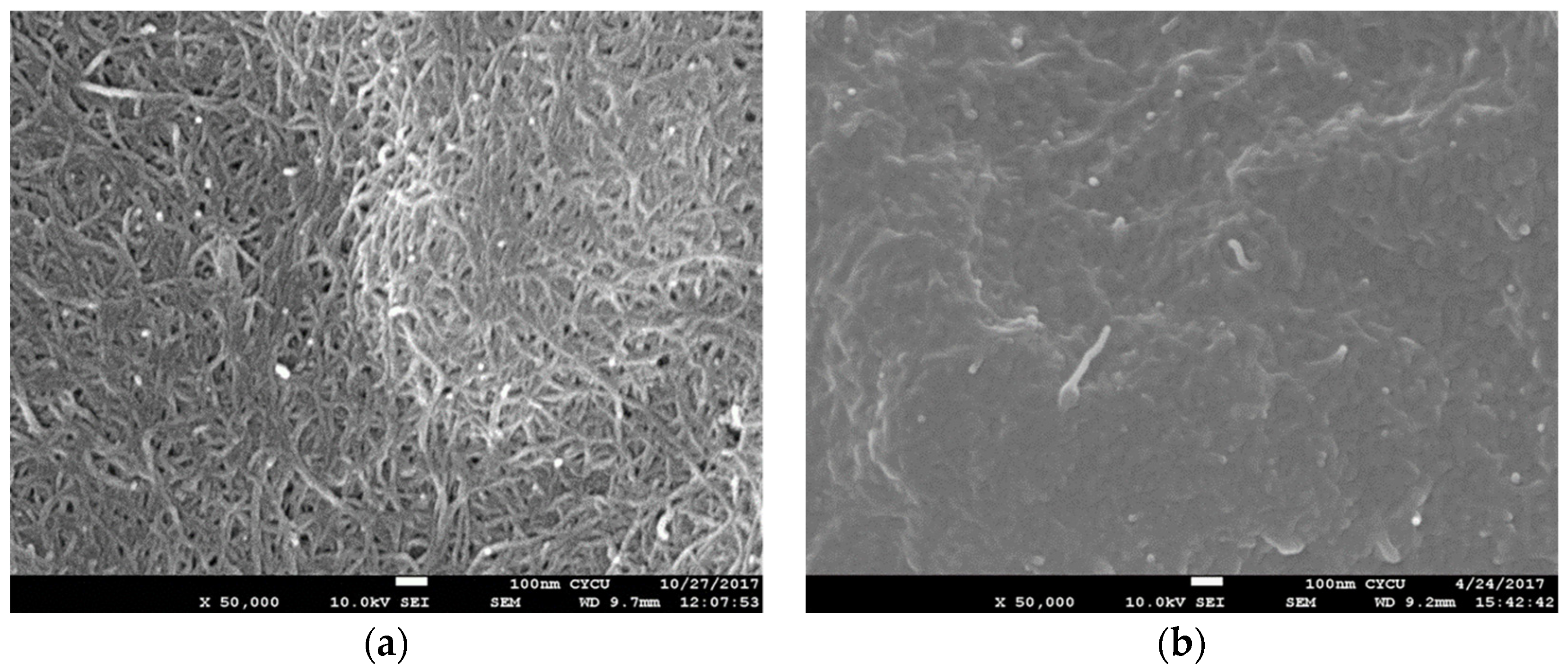


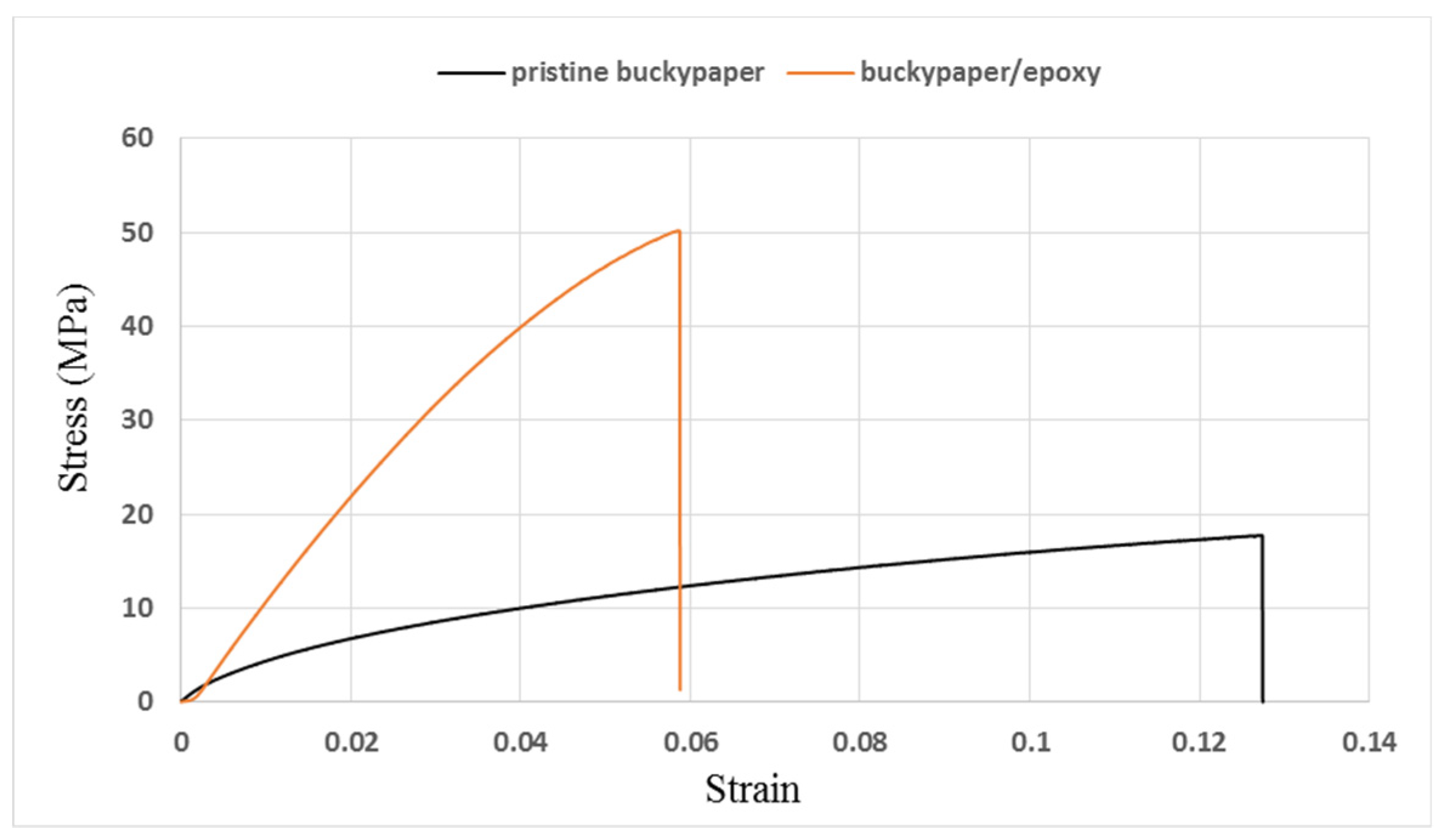



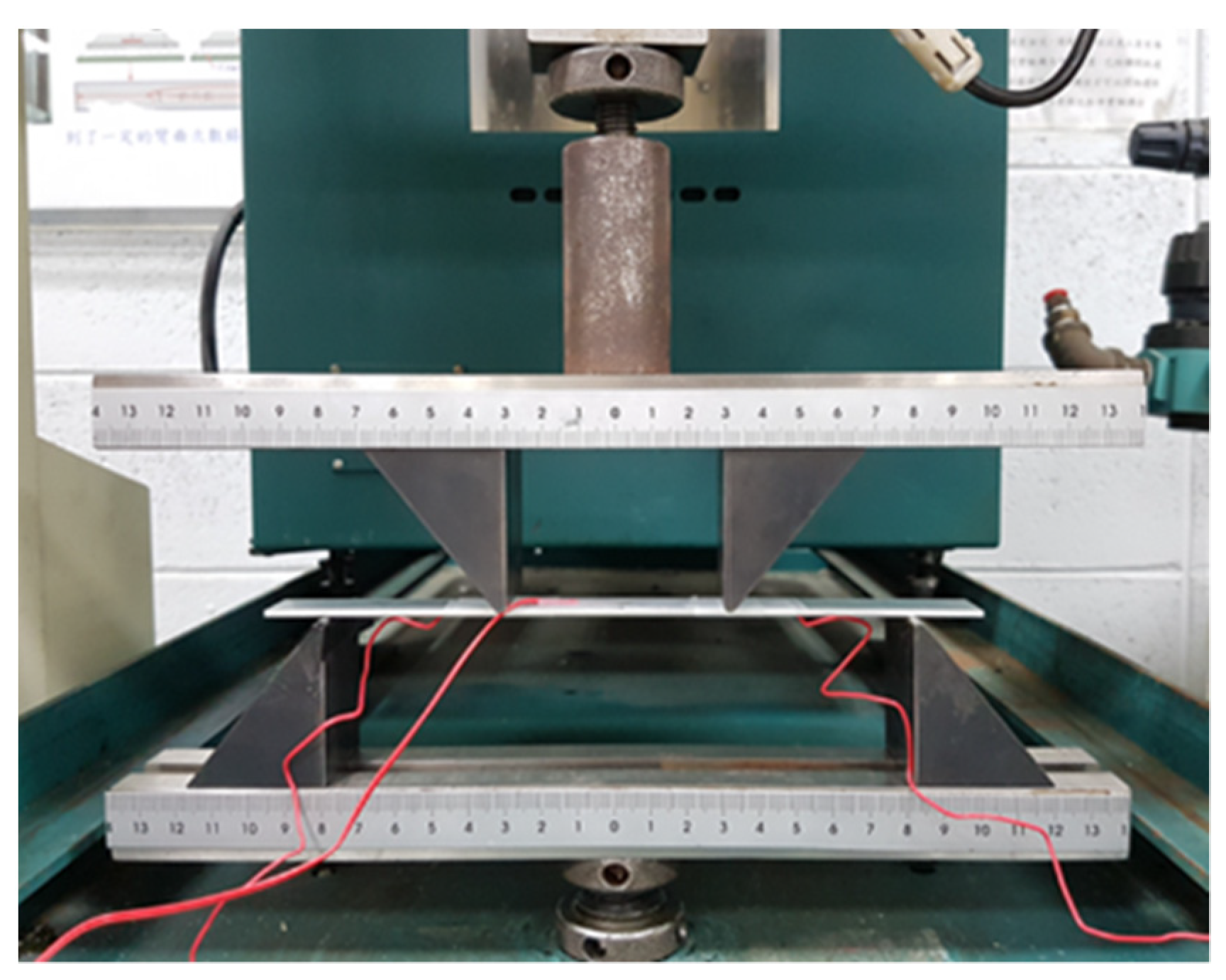

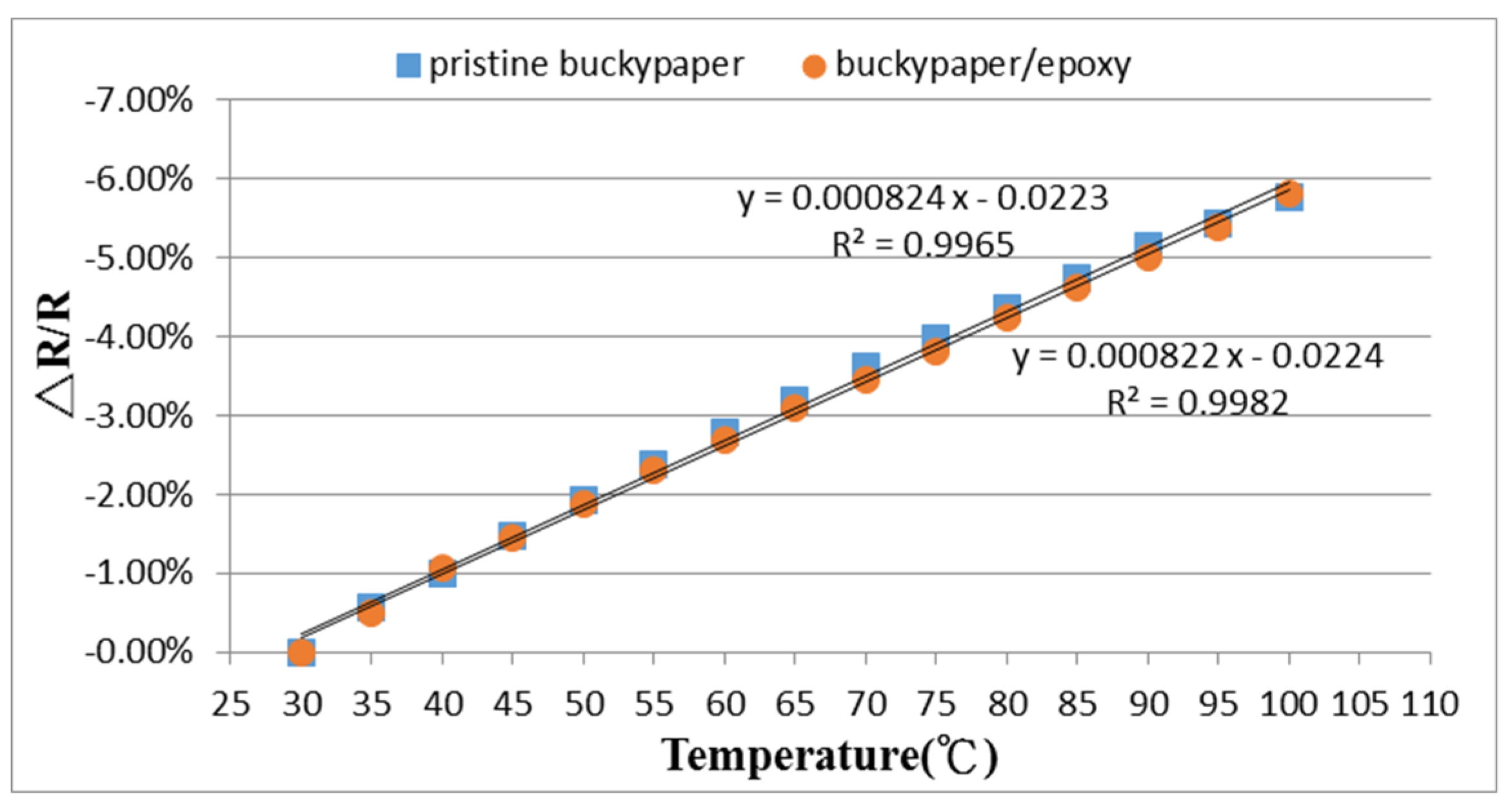
| Tensile Properties | Pristine Buckypaper | Buckypaper/Epoxy Composite | Epoxy |
|---|---|---|---|
| Elastic modulus GPa | 0.68 ± 0.025 | 1.24 ± 0.029 | 0.99 ± 0.01 |
| Ultimate strength MPa | 17.3 ± 0.29 | 50.8 ± 1.60 | 40.4 ± 0.23 |
| Fracture strain | 0.122 ± 0.003 | 0.060 ± 0.002 | 0.041 ± 0.0002 |
Publisher’s Note: MDPI stays neutral with regard to jurisdictional claims in published maps and institutional affiliations. |
© 2020 by the authors. Licensee MDPI, Basel, Switzerland. This article is an open access article distributed under the terms and conditions of the Creative Commons Attribution (CC BY) license (http://creativecommons.org/licenses/by/4.0/).
Share and Cite
Her, S.-C.; Hsu, W.-C. Sensing Performance and Mechanical Properties of Buckypaper Impregnated with Epoxy Resin. Nanomaterials 2020, 10, 2258. https://doi.org/10.3390/nano10112258
Her S-C, Hsu W-C. Sensing Performance and Mechanical Properties of Buckypaper Impregnated with Epoxy Resin. Nanomaterials. 2020; 10(11):2258. https://doi.org/10.3390/nano10112258
Chicago/Turabian StyleHer, Shiuh-Chuan, and Wei-Chun Hsu. 2020. "Sensing Performance and Mechanical Properties of Buckypaper Impregnated with Epoxy Resin" Nanomaterials 10, no. 11: 2258. https://doi.org/10.3390/nano10112258
APA StyleHer, S.-C., & Hsu, W.-C. (2020). Sensing Performance and Mechanical Properties of Buckypaper Impregnated with Epoxy Resin. Nanomaterials, 10(11), 2258. https://doi.org/10.3390/nano10112258




